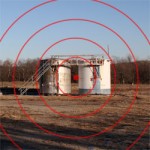Oklahoma Earthquake Was Largest Linked to Injection Wells, New Study Suggests
A University of Oklahoma seismologist’s research, released today, provides further evidence that Oklahoma’s largest-recorded earthquake was triggered by injection wells used by the oil and gas industry.
Katie Keranen’s findings, published today in the geoscience journal Geology, adds to a growing chorus of scientific evidence suggesting that injection and disposal wells are likely causing an uptick of earthquakes in the continental United States.
The research centered on a sequence of earthquakes that occurred in November 2011 near Prague, Okla. They included a 5.7-magnitude quake on Nov. 6, the largest quake triggered by injection wells to date, according to the research.
The analysis suggests that injection-induced earthquakes could be larger than previously thought, and that they could occur on much longer timescales.
“This is basically a different class of induced earthquake,” Keranen tells StateImpact.

Katie M. Keranen, Heather M. Savage, Geoffrey A. Abers and Elizabeth S. Cochran / Geology
Click here to read a copy of the research, which was published March 26 by the geosciences journal Geology.
Oklahoma’s November 2011 earthquake was the state’s largest recorded with modern instrumentation. Two people were injured in the quake, which destroyed 14 homes, “buckled” pavement and was felt in 17 states, according to the paper.
Keranen’s analysis — co-written with Columbia University’s Heather Savage and Geoffrey Abers, and the U.S. Geological Survey’s Elizabeth Cochran — is based on data collected from more than a dozen seismometers deployed during the November 2011 earthquake sequence and is correlated with data collected by the Oklahoma Corporation Commission, the state’s oil and gas regulator.
Prague is situated near a fault line and an oil field that was heavily used in the 1950s and 1960s. Petroleum production in the area has dwindled since then, but in the early 1990s, operators started installing injection wells in the oil field. Such wells are used to “recover” oil and gas from depleted reservoirs, or to store toxic waste fluid produced during drilling.
Currently, when seismologists evaluate the likelihood that an earthquake was induced by injection wells, they look for earthquakes that occur within months of fluid injection. But Keranen’s research suggests a much longer lag between cause and effect:
Her findings also suggest that induced earthquakes could be larger than previously thought, since this type of deep waste fluid injection has the potential to unlock tectonic stresses built up over decades.“Here we present a potential case of fluid injection into isolated pockets resulting in seismicity delayed by nearly 20 years from the initiation of injection, and by 5 years following the most substantial increase in wellhead pressure.”
More than 1,400 earthquakes were recorded in Oklahoma in 2011, the most seismically active year on record, data show. Oklahoma isn’t alone. Seismic activity has also increased in other states throughout the middle of the country. Seismologists suspect that oil and gas activity may have triggered earthquakes in Texas, Arkansas, Colorado and Ohio.
Regulators in Arkansas voted to ban injection wells from one particular region after a series of earthquakes was recorded in that state in 2011. Oil and gas regulators in Colorado now require a review by a state seismologist before injection well permits are issued, and Illinois is considering installing a “traffic light” system that would require injection wells to stop operating if related earthquakes cause a public safety risk.
But earthquake risks aren’t a part of rule overhauls in California, Texas or New York, E&E’s Mike Soraghan reports. And no such changes are being considered in Oklahoma, the Corporation Commission’s Matt Skinner told StateImpact in January. Skinner didn’t immediately respond to questions about the new research.
Oklahoma’s official seismologist — the Geological Survey’s Austin Holland — is skeptical of the link between injection wells an earthquakes, a view shared by the Corporation Commission and the Oklahoma Independent Petroleum Association, a trade group that lobbies for the interests of oil and gas producers. More data is needed, Holland says.
In a policy paper written in response to the new research, the Geological Survey says “the interpretation that best fits current data is that the Prague Earthquake Sequence was the result of natural causes.”


